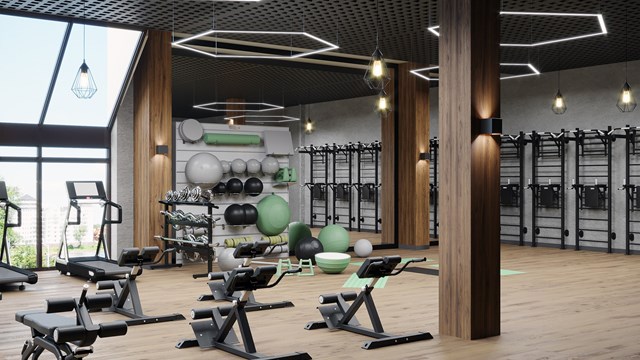Jack and his wife Rachel live in Boston, happy in a two-bedroom, two-bath condo with a parking spot. Assessments are criminally low, the building is dog-friendly, and it is literally a half block from public transit. While they have a small balcony off the master bedroom that they enjoy in the warmer months by planting a small herb garden and semi-successful tomatoes, and sunbathing on the weekends, they knew that just two floors above them existed a true Eden: a gorgeous rooftop deck shared by the two penthouse units.
Rachel first experienced it during a condo meeting. “In a word, it’s exquisite,” she says. “There are wraparound views of the whole city, and enough room for ample deck furniture and a grill. You can see everything!” Jack was also taken by the space. “You experience the city a little differently when you can see it privately from above,” he adds.
So when one of their penthouse neighbors put their unit up for sale last fall, Jack and Rachel were intrigued. “We couldn’t afford it at all, and we love our current place, but we couldn’t help but consider it simply for that roof deck,” says Rachel. They checked out the unit during an open house, and on closer inspection decided they didn’t love the layout or design enough to tip the scales, but it still feels like the one that got away. “I hope the new guy who lives there has many, many summer parties. We’ll be at every one of them,” says Jack.
Jack and Rachel aren’t alone in their roof space covetousness; Daniel Wallace, a landscape architect with Sudbury Design Group in Sudbury, Massachusetts, adds, “Urban landscapes are very desirable to those who are downsizing from their suburban properties, and whether public or private, access to an urban oasis is a great asset in the confines of city living. Owners and associations recognize the value that these spaces offer.”
Way Up There
The roof of a multifamily building can be the source of pain (leaking, caving, peeling) and pleasure (views, summer grilling, sunbathing sans gawkers). Regardless of whether it’s just tar paper and gravel, or a fully-finished social space with all the trimmings, it’s the first line of defense against whatever the skies and wind bring down. And if it is as lovely as Jack and Rachel’s just-out-of-grasp roof, it can also bear the brunt of more wear-and-tear than a rooftop that only sees the occasional HVAC repair man or flock of pigeons. They key to enjoying your roof through the seasons, from 4th of July fetes to waterlogged spring showers, is maintenance, maintenance, and – you guessed it – maintenance.
A lot more of your neighbors enjoy rooftops than you might realize. Michael Kaspar, regional sales manager at Allied Building Products in Hicksville, New York, speculates that a good estimate would be 60 to 70 percent of the rooftops in metro regions are used as an amenity space, i.e. a space where building residents and their guests are allowed to congregate. He notes that while “there is a lot of speculation out there as to percentages and square footages, with no exact data from industry professionals, each region has roughly five to seven million square feet of amenity space rooftops.”
Most buildings’ roof decks were built as part of their initial construction. “Many original amenity space roof assemblies consisted of coal tar pitch roofs with a quarry tile walking surface,” Kaspar continues. “These roof assemblies are typically encountered when a reroofing occurs.”
Building On High
If a building that doesn’t have a roof deck wants to overhaul their existing, plain-Jane roof into an urban oasis, there is hope for them yet. It just takes a lot of pre-planning, research, and prudent decision making with the help of qualified, competent professionals.
“I think the most important part of adding a usable roof deck to any building is the design phase,” says Harry Friedman of Champion Roofing Inc. in Bensenville, Illinois. “You have to make sure the building can support the weight, the constant movement, and activities that will be taking place on the deck. Clearly then the roof design is the most important component after that. You don’t want to have leaks, and then have to remove the deck to access the problem areas.”
Because you are dealing with one of the most important elements of your building (it’s not like buying a new carpet runner for the foyer), this isn’t a job for Home Depot. “Retaining design professionals to navigate through this process is probably the biggest key,” says Kaspar, not only to help make your roof deck live up to its potential, but also to stay on the right side of building code compliance and safety regulations.
Zoning ordinances govern where and how roof decks can be built, and vary from location to location. Local building codes will dictate the design and construction options available to you. “New construction is straightforward, and designers must adhere to the latest adopted codes for their region,” says Kaspar. He goes on to explain that if a building wants to convert an existing, purely-functional roof into an amenity, “Several considerations must be reviewed for compliance prior to receiving a change to the building’s Certificate of Occupancy.”
Kaspar advises that minimum requirements include, but are certainly not limited to: bringing in a structural engineer to review and verify the suitability of the roof with regards to required loads; fall protection to prevent injury (or worse); adequate lighting; emergency egress, and fire extinguishers. If all the factors of drainage, weight limits, and waterproofing were properly accounted for in the design phase of the whole building, according to Friedman, “Basic roof maintenance would then apply, without any specific needs because of a deck installed.”
Doing It Right
When it comes to putting a usable rooftop space on an existing building, there are a number of design and engineering challenges that go beyond safety. Putting a high-traffic surface on a delicate, leak-prone structure is a tricky proposition, and one that requires a great deal of expertise. “Essentially the trick is to have a happy medium whereby the building is watertight and still allows for enjoyment of a deck,” says Friedman. “I personally like to see decks built that float above the roofing system and keep penetrations to a minimum. The more the design phase achieves that, the less headaches will occur down the line.”
Sean Skapars, owner of Skapars Design Group LLC in Cambridge, Massachusetts, concurs, and says that creating a roof deck garden is not a process to be lightly undertaken, precisely because the materials needed must be so lightweight. “Roofs tend to be pretty well constructed and are not necessarily weak, but you have to consider weight. You don’t want to damage the structure, so instead of plopping down huge heavy planters, we custom design and build our own lightweight planters; and instead of gravel, we use foam pellets and light potting soil.” Wallace agrees that weight must be considered, and says that “the first step in planning a rooftop deck is to engage a structural engineer to assess structural feasibility. Rooftops are typically only designed to support the weight of historical snowfall. An engineer is required to determine what weight the roof can support and/or what efforts will be necessary to increase the strength of the roof.” Carr concurs, but adds, “Be sure to look into issues of warranties on the roof which may exist. The vinyl roof membrane surfaces may be subject to damage if you put weight onto it, and you need to talk to the manufacturer of the original surface to confirm what can be put onto the roof surface without violating any existing warranties.”
The pros consulted for this article all agree that it’s best to have any modifications to your building’s roof system reviewed by a roof pro – ideally the one who originally installed it, and therefore knows it best. “Owners tend to have mechanical, electrical, and plumbing or sub-contractors install equipment without coordinating their work with roofing professionals,” says Kaspar.
Water is definitely the number-one threat to roof integrity, regardless of whether there’s a usable deck surface there or not. Rain and snow both take a toll, but by far the most damaging element is standing water pooled on a roof’s surface. Explains Kaspar, “Maintenance concerns are mainly access to the drains and flashing at penetration points. Access to these components is critical in providing longevity of a roof system. Drains should be maintained on a regular basis, and more frequently if there are plantings or ‘green roof’ elements on the surface. Access to the penetration flashings is also good practice, because history has shown that when leaks occur, it’s usually at a deficient or damaged penetration flashing. It’s rare for a breach to occur within the field of the roof unless there’s been physical damage to the membrane.”
Other Considerations
Designing an enviable roof deck or crafting a new private sanctuary in the sky is getting easier and more fun, with new technical innovations in both systems and materials becoming available. For his part, Kaspar specifically notes that the advancement of leak detection systems is particularly exciting. “There are multiple types of active or passive systems available for use prior to installation to verify the integrity of the roofing/waterproofing membrane system,” he says. Friedman also notes the recent uses of plastic laminate materials instead of wood, which are “virtually maintenance-free and very strong.”
With summer approaching and the skies clearing, architectural fantasies are filled with sun-soaked square footage and strappy sandals, chilly beers and perfectly cooked burgers, all surrounded by views of the buildings that make up the cities where we reside and that we love.
Jack and Rachel sent their new penthouse neighbor a lovely welcome basket when he moved in. “We gave him a bottle of wine, a gift certificate to the local coffee shop and a few restaurant suggestions,” says Rachel. “We are absolutely buttering him up to invite us up in the summer. We have no roof deck, but we also have no shame.”
Rebecca Fons is a freelance writer and frequent contributor to New England Condominium.










Leave a Comment